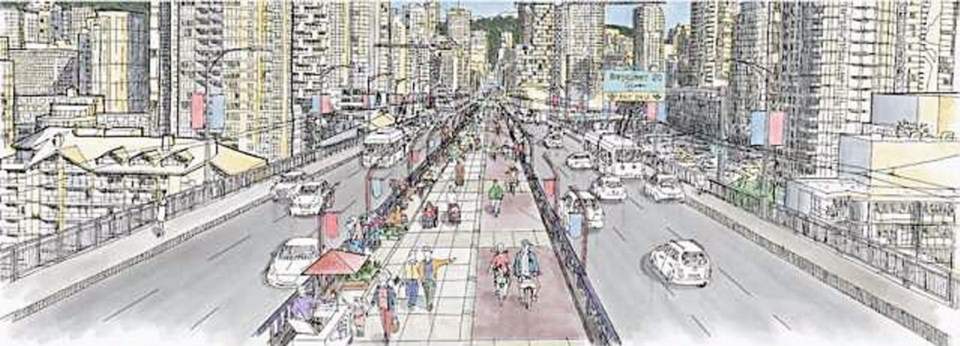The redesign of the Granville Street Bridge is veering in a new direction after Vancouver residents made it clear to city hall what they want for the crossing’s future.
On Monday, the City of Vancouver unveiled results of a public consultation process conducted in September that garnered almost 8,000 responses after residents were presented with six options for how to reallocate two of the Granville Bridge’s traffic lanes to create pathways for travelling by foot, bike and wheelchair. It turned out the option senior city staff had publicly endorsed, an elevated pedestrian/bicycle path in the bridge’s middle two lanes, was not a hit with the public.
City staff believed the centre-lane design was “the right technical answer,” said Paul Storer, Vancouver’s manager of transportation design, but the public favoured creating biking/walking/rolling routes on the bridge’s west side.
“We heard really clearly from people that the centre wasn’t the one people wanted,” Storer said. “We often hear concerns that people aren’t being listened to, and in all of our projects, we absolutely do listen. That doesn’t mean that we can do everything that everyone wants, but this is a great example of how that public feedback really influences a project.”
Respondents preferred the west-side pathway option because of the views and experience that being at one side of the bridge offered, Storer said. But it also has the bonus of being less expensive than the centre-lane option.
Successive councils have set targets for reducing the Vancouver’s carbon footprint, and a crucial part of that effort will be increasing the number of people walking, rolling and biking on the three bridges crossing False Creek, Storer said. After changes over the past decade to the Burrard and Cambie bridges, Granville remained as the final False Creek bridge needing changes.
The bridge, which opened in 1954, is particularly challenging to make more friendly to bikes and pedestrians, Storer said, in part because it was designed to be in a freeway network that was never built. The city abandoned, in the 1960s, its plans to build a downtown freeway.
The eight-lane bridge has “a lot of excess capacity,” Storer said, so the reduction of car lanes should not reduce traffic flows.
The cost estimate for the recommended design is between $30 million and $40 million.
Only a minority, about 10 per cent, of participants during the consultation process expressed the opinion that the city should do nothing and not change the bridge, Storer said, “and if we want to meet our targets, we don’t think that doing nothing is an option.”
Without specifically commenting on whether the Granville proposal provides good value for money, transportation expert Alex Boston said, generally, it’s good public policy to invest in infrastructure that makes it easier for people to get around without increasing the number of cars on the road.
Boston, executive director of Simon Fraser University’s Renewable Cities program, pointed to the Burrard and Cambie bridge changes, which helped increase bike and pedestrian trips, without worsening congestion.
“The net result is we’re moving more people across that bridge, and it’s difficult for people to understand that through a very strategic ‘road-dieting’ approach, we can actually accommodate the same number of vehicles,” Boston said.
The term “road-dieting” is used in the transportation planning field to describe reducing lanes dedicated to car travel. The U.S. Department of Transportation encourages local governments to look at “road diets,” and has reported that this approach can lead to safer streets and better quality of life without increasing congestion.
Vancouver Mayor Kennedy Stewart said the Granville Street Bridge is a sort of “a welcome to the city, so it should be pretty grand.”
“Have you ever walked across that bridge? It’s terrible, and it’s scary. So I think we have to do something,” Stewart said. “It’s a forever investment, so I’d be in favour of investing a bit more now and getting it right than going back and fixing it all the time.”
City staff will now conduct the final phase of public consultation on the recommended design, with open houses on Jan. 24, 25, and 28, and an online survey at www.vancouver.ca/granvilleconnector until Feb. 10.
If council approves the project, construction could begin in 2021, and be completed by 2022.
— Dan Fumano, Vancouver Sun



